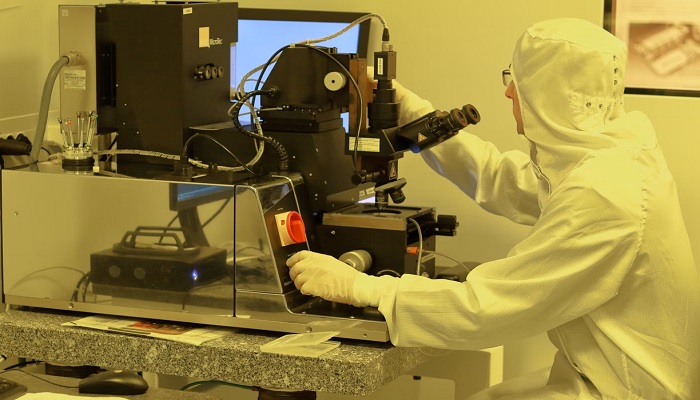Medicines, food, electronics: Why the world is turning to nanotechnology
Advanced countries have moved in quickly to utilise fantastic opportunities that are offered by nanotechnology, writes Atta-ur-Rahman
June 22, 2022

When the size of materials is reduced to one millionth of a millimeter (nanometer, nm), their properties change dramatically at the ‘nanoscale’.
The first observations and size measurements of nanoparticles were made during the early 1900s by Richard Adolf Zsigmondy, winner of the 1925 Nobel Prize in Chemistry. He carried out studies on gold and other materials with sizes of about 10 nm using an ultramicroscope.
The change of properties including colour of some materials when reduced to the nanoscale is exemplified by gold which becomes blue-green, red or purple in colour, depending on the particle size.
However, it was not until the 1980s that the field took off after the invention of the scanning tunneling microscope in 1981. It was discovered in 1985 that when graphite was heated to high temperatures using lasers, certain football-like molecules, named fullerenes, were formed made of pure carbon.
These exciting molecules have found many applications as super lubricants, for slow-release drugs against cancer and for fabricating new materials.
Nanotechnology is today finding a multitude of applications in agriculture, food, water purification, cosmetics, electronics, medicine, new materials and many other fields.
The advanced countries have moved in quickly to utilise the fantastic opportunities that are offered by nanotechnology with the US having the largest share in the nanotechnology market, followed by Japan, Germany, France and the UK.
Nano electronics alone is estimated to have a market size of above $5 trillion and it is expanding rapidly.
In Pakistan, the first dedicated institution in this exciting field has been developed through a generous grant of the Latif Ebrahim Jamal Foundation to the University of Karachi. Based within Pakistan’s premier research institution, (the International Center for Chemical and Biological Sciences), the Latif Ebrahim Jamal Center for Nanotechnology represents a wonderful example of public-private partnership in the education sector.
The research work underway focuses on the development of nano-pharmaceuticals, which is a hot and rapidly growing field. Nano-medicines exhibit significantly improved absorption in the human body and can therefore be deployed in lower doses with improved efficacy and lower toxicity.
The field is also finding many applications in the food industry.
Nano-food products are estimated to have a market of $25 billion that is expanding rapidly. Nanotechnology is being employed in storage and protection of food products.
Nano-capsules with pesticides incorporated in them have been developed to reduce the consumption of pesticides in agriculture. These nano-capsules containing pesticides are released only in the stomach of insects, so that plants and humans are protected from their harmful effects.
Nano-sensors have been developed that can sense when plants require water, fertilizer and nutrients. This allows minimum required amounts of water and nutrients to be delivered when needed, thereby resulting in saving of huge wastages and ensuring optimum yields.
Carbon nanotubes about 10,000 times thinner than a human hair, are now being used in many different applications including water nano- filters and for rapid and sensitive detection of certain marker chemicals well before the onset of diseases, thereby allowing persons to take preemptive action.
It has been found that one can develop solar cells using nanotubes, and these can then be painted on walls or windows, providing a source of clean energy. Another important application in agriculture is the use of carbon nanotubes for water desalination.
Amazing "smart materials" have also been developed that can remember their shape. If you bend or twist such materials, they restore themselves automatically to their original shape. You may well be travelling in a car tomorrow built of such materials. If the car has an accident and is dented, the material will restore itself to its original shape as it has a built-in memory.
Self-healing paints have already been developed. New smart materials that can adopt different shapes in response to electric currents or magnetic fields have also been developed. The US army has been using them in the form of powerful bulletproof "living" exo-skeletons that can be worn by Robo-Cop type soldiers during combat.
Another related incredible development is that of bulletproof paper. Made of nano-cellulose, the paper is stronger than steel and impervious to bullets so that light, absorbent bullet-proof jackets can be made from it.
Nano-materials are finding applications in space craft, airplanes and longer lasting light weight batteries. The use of a new carbon material "graphene" is having a profound impact on new electronic devices such as mobile phone batteries.
Textiles using nanotechnology are estimated to have a market size of $125 billion. Nanotechnology has been used for the economical production of lightweight textiles, tennis racquets and other sports goods.
An interesting development has been the invention of specialised textile materials with mosquito repellent properties built into their structure. This avoids the use of insect repellent lotions and sprays.
Nanomaterials have also found use in the fabrication of insect-like miniature drones that can be remotely operated and used for spying purposes.
Fitted with cameras and sound systems, they can be placed on the desks or walls of rooms of our army chief and transfer all that is going on to an embassy located miles away. They look like flies or other small insects and are undetectable to standard detection tools.
When I was the federal minister of science & technology in 2001, I had established the National Commission of Nanotechnology under eminent scientist Dr N M Butt. Unfortunately, the government later decided that we had no need for this “useless field”, as they called it, and all programmes of the commission were stopped. Pakistan can only progress if it is led by a technocrat, sincere and honest government.
The writer is the former federal minister for science and technology and former founding chairman of the HEC. He can be reached at: [email protected]
Originally published in The News











